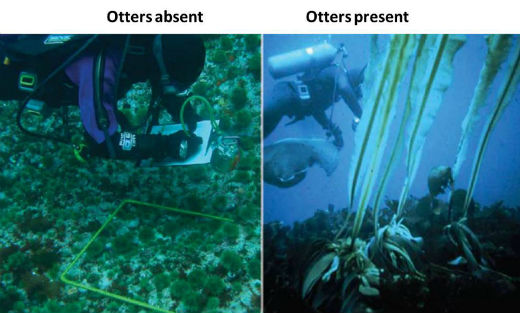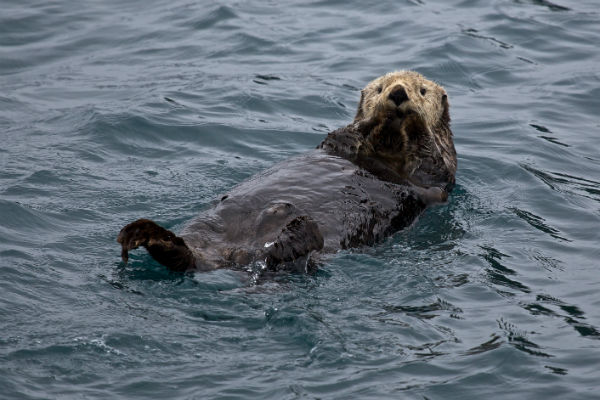Background
Prior to 1911, sea otters (Enhydra lutris) were extirpated from southeastern Alaska by the Pacific maritime fur trade. In1965, sea otters were translocated from Amchitka Island (Aleutian Islands) to the outer coast of southeastern Alaska and by the early 1990’s, small numbers of sea otters were documented at the mouth of Glacier Bay. In response, the United States Geological Survey (USGS) Alaska Science Center initiated a long-term study to quantify the spatial distribution and abundance of sea otters in Glacier Bay using aerial surveys. Since 1993, sea otters have expanded rapidly into Glacier Bay and the most recent abundance estimate in 2012 was > 8,000 otters, representing an average annual growth rate of 42%. This rapid recolonization exceeds the theoretical maximum population growth rate, suggesting that immigration from outside of Glacier Bay is also likely occurring (Esslinger et al. 2015).

Estes et al. 2011
Sea otters typically inhabit nearshore areas and forage on a variety of marine species including mussels, clams, sea urchins, crabs, and occasionally fish. Sea otters are a keystone species, and the effects of sea otter predation in nearshore communities are well-documented in rocky substrate habitats in the North Pacific Ocean. When otters are present, they eat urchins and urchin density decreases. Lower urchin density reduces grazing pressure on kelp, resulting in a more diverse nearshore ecosystem (see image from Estes et al 2011).
Sea otters as a vital sign

NPS photo/K. Thoresen
In 2016, the Southeast Alaska Inventory & Monitoring Network (SEAN), the USGS Alaska Science Center, Colorado State University, and Glacier Bay National Park initiated a study to better understand the spatial distribution, abundance, and colonization dynamics of sea otters in Glacier Bay National Park. This new research and monitoring effort builds upon existing USGS sea otter distribution and abundance data to better understand the ecological processes governing changes in sea otter distribution and abundance in Glacier Bay National Park by using contemporary modeling methods and developing an adaptive monitoring framework that minimizes model uncertainty and maximizes survey efficiency. The project will provide a foundation for understanding the colonization dynamics of sea otters and their influence on nearshore communities in Glacier Bay National Park.
For more information
Contact:
Dr. Jamie Womble, Wildlife Biologist, jamie_womble@nps.gov
Mike Bower, SEAN Program Manager, michael_bower@nps.gov
Reports and Data Access: https://science.nature.nps.gov/im/units/sean/
Literature cited:
Esslinger, G.G., Esler, D., Howlin, S., and Starcevich, L.A., 2015, Monitoring population status of sea otters (Enhydra lutris) in Glacier Bay National Park and Preserve, Alaska. USGS open file report, 2015-1119.
Estes, J.A. et al. 2011. Trophic downgrading of planet Earth. Science, 333, 301.
Web article by Erin Kunisch
Updated January 2016
Click here to print a copy of this article.
Last updated: September 15, 2016
